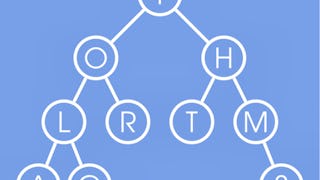What Is a Microsoft Copilot Certification?
May 5, 2025
Article



This course is part of Introduction to Discrete Mathematics for Computer Science Specialization


Instructors: Alexander S. Kulikov
Instructor ratings
We asked all learners to give feedback on our instructors based on the quality of their teaching style.


54,984 already enrolled
Included with 
(1,049 reviews)
(1,049 reviews)

Add to your LinkedIn profile
30 assignments



Add this credential to your LinkedIn profile, resume, or CV
Share it on social media and in your performance review

We invite you to a fascinating journey into Graph Theory — an area which connects the elegance of painting and the rigor of mathematics; is simple, but not unsophisticated. Graph Theory gives us, both an easy way to pictorially represent many major mathematical results, and insights into the deep theories behind them.
In this online course, among other intriguing applications, we will see how GPS systems find shortest routes, how engineers design integrated circuits, how biologists assemble genomes, why a political map can always be colored using a few colors. We will study Ramsey Theory which proves that in a large system, complete disorder is impossible! By the end of the course, we will implement an algorithm which finds an optimal assignment of students to schools. This algorithm, developed by David Gale and Lloyd S. Shapley, was later recognized by the conferral of Nobel Prize in Economics. As prerequisites we assume only basic math (e.g., we expect you to know what is a square or how to add fractions), basic programming in python (functions, loops, recursion), common sense and curiosity. Our intended audience are all people that work or plan to work in IT, starting from motivated high school students.
What are graphs? What do we need them for? This week we'll see that a graph is a simple pictorial way to represent almost any relations between objects. We'll see that we use graph applications daily! We'll learn what graphs are, when and how to use them, how to draw graphs, and we'll also see the most important graph classes. We start off with two interactive puzzles. While they may be hard, they demonstrate the power of graph theory very well! If you don't find these puzzles easy, please see the videos and reading materials after them.
14 videos6 readings5 assignments1 ungraded lab
We’ll consider connected components of a graph and how they can be used to implement a simple program for solving the Guarini puzzle and for proving optimality of a certain protocol. We’ll see how to find a valid ordering of a to-do list or project dependency graph. Finally, we’ll figure out the dramatic difference between seemingly similar Eulerian cycles and Hamiltonian cycles, and we’ll see how they are used in genome assembly!
12 videos4 readings7 assignments5 ungraded labs
This week we will study three main graph classes: trees, bipartite graphs, and planar graphs. We'll define minimum spanning trees, and then develop an algorithm which finds the cheapest way to connect arbitrary cities. We'll study matchings in bipartite graphs, and see when a set of jobs can be filled by applicants. We'll also learn what planar graphs are, and see when subway stations can be connected without intersections. Stay tuned for more interactive puzzles!
11 videos4 readings6 assignments2 ungraded labs
We'll focus on the graph parameters and related problems. First, we'll define graph colorings, and see why political maps can be colored in just four colors. Then we will see how cliques and independent sets are related in graphs. Using these notions, we'll prove Ramsey Theorem which states that in a large system, complete disorder is impossible! Finally, we'll study vertex covers, and learn how to find the minimum number of computers which control all network connections.
14 videos5 readings8 assignments1 ungraded lab
This week we'll develop an algorithm that finds the maximum amount of water which can be routed in a given water supply network. This algorithm is also used in practice for optimization of road traffic and airline scheduling. We'll see how flows in networks are related to matchings in bipartite graphs. We'll then develop an algorithm which finds stable matchings in bipartite graphs. This algorithm solves the problem of matching students with schools, doctors with hospitals, and organ donors with patients. By the end of this week, we'll implement an algorithm which won the Nobel Prize in Economics!
13 videos6 readings4 assignments
We asked all learners to give feedback on our instructors based on the quality of their teaching style.




UC San Diego is an academic powerhouse and economic engine, recognized as one of the top 10 public universities by U.S. News and World Report. Innovation is central to who we are and what we do. Here, students learn that knowledge isn't just acquired in the classroom—life is their laboratory.

University of California San Diego
Course

Rice University
Course

University of Colorado Boulder
Course

Fractal Analytics
Course




1,049 reviews
66.63%
23.35%
6.57%
2.09%
1.33%
Showing 3 of 1049
Reviewed on Nov 24, 2017
This course is really good. If someone has interest in graph theory or he wants to learn it, then this course is definitely a good start.
Reviewed on Aug 8, 2020
Though it is beginner level course some concepts are hard to grasp. Gives perfect introduction in graph theory. Useful for computer science subjects.
Reviewed on Jun 7, 2020
The course was excellent apart from the Ford Fulkerson Theorem in the last week where it was rather shabby and hasty. The Gale-Shapley Algorithm was fun however!

Unlimited access to 10,000+ world-class courses, hands-on projects, and job-ready certificate programs - all included in your subscription
Earn a degree from world-class universities - 100% online
Upskill your employees to excel in the digital economy
Access to lectures and assignments depends on your type of enrollment. If you take a course in audit mode, you will be able to see most course materials for free. To access graded assignments and to earn a Certificate, you will need to purchase the Certificate experience, during or after your audit. If you don't see the audit option:
The course may not offer an audit option. You can try a Free Trial instead, or apply for Financial Aid.
The course may offer 'Full Course, No Certificate' instead. This option lets you see all course materials, submit required assessments, and get a final grade. This also means that you will not be able to purchase a Certificate experience.
When you enroll in the course, you get access to all of the courses in the Specialization, and you earn a certificate when you complete the work. Your electronic Certificate will be added to your Accomplishments page - from there, you can print your Certificate or add it to your LinkedIn profile. If you only want to read and view the course content, you can audit the course for free.
If you subscribed, you get a 7-day free trial during which you can cancel at no penalty. After that, we don’t give refunds, but you can cancel your subscription at any time. See our full refund policy.
Yes. In select learning programs, you can apply for financial aid or a scholarship if you can’t afford the enrollment fee. If fin aid or scholarship is available for your learning program selection, you’ll find a link to apply on the description page.
Financial aid available,
Learn on your own time from top universities and businesses.
Already on Coursera?
Having trouble logging in? Learner help center
This site is protected by reCAPTCHA Enterprise and the Google Privacy Policy and Terms of Service apply.